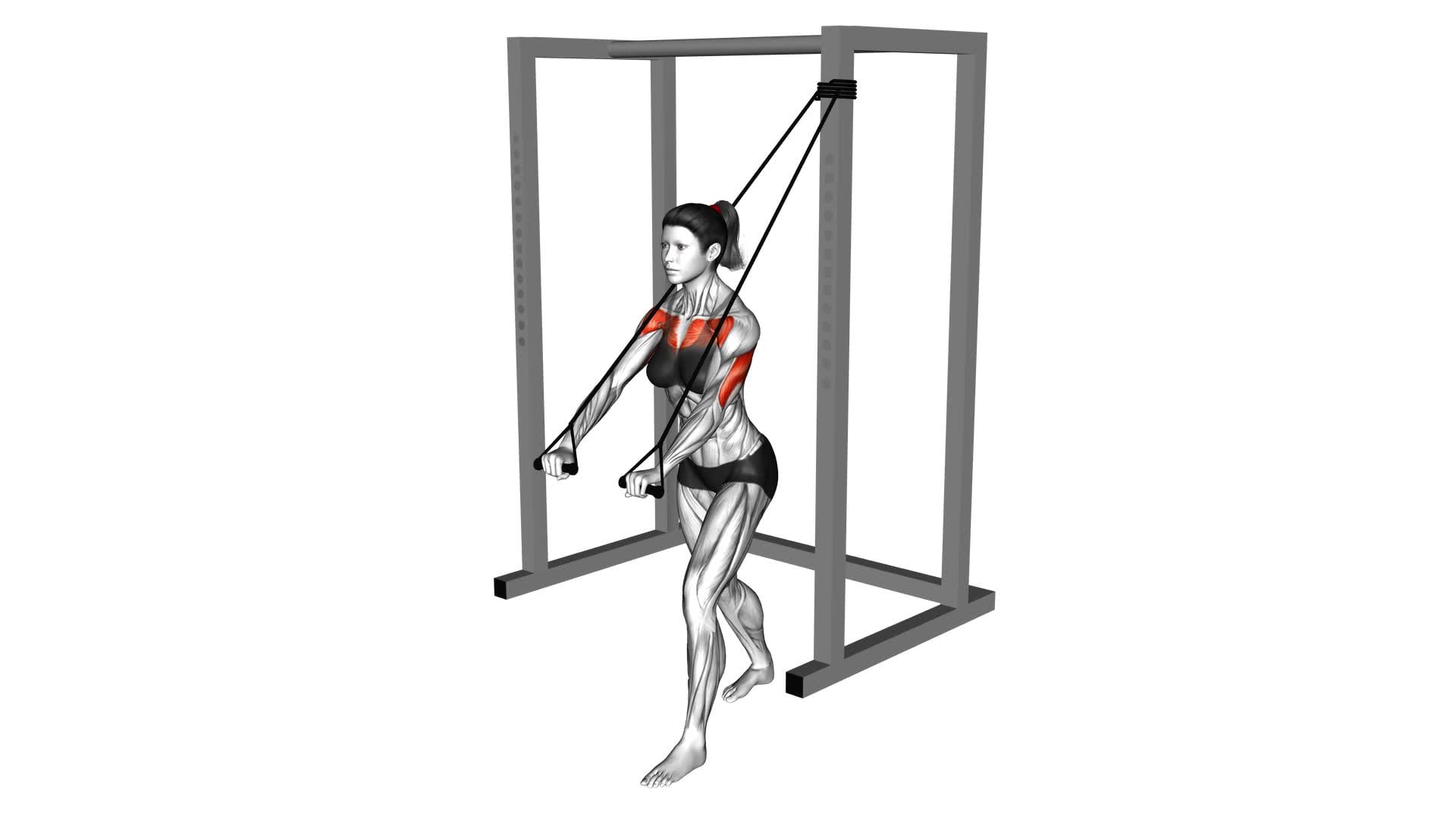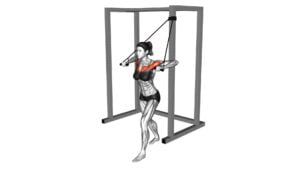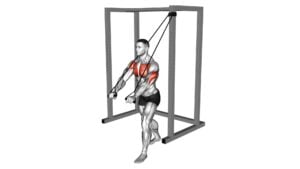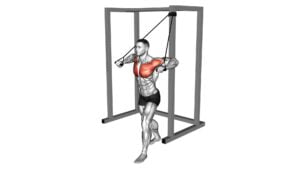Band Low Chest Press (female) – Video Exercise Guide & Tips

Are you looking for a challenging chest exercise that targets your muscles effectively? Look no further than the Band Low Chest Press.
Watch This Exercise Video
This video exercise guide will show you the proper set-up and technique for performing this exercise. You'll also learn common mistakes to avoid and get tips for progression and variation.
Get ready to strengthen and tone your chest muscles with this effective exercise!
Key Takeaways
- The Band Low Chest Press builds strength and definition in chest muscles.
- It targets the pectoralis major, the main chest muscle, engaging it throughout the entire range of motion.
- The exercise provides constant tension on chest muscles, promoting muscle growth.
- It also improves upper body stability and posture.
Benefits of the Band Low Chest Press
One benefit of the Band Low Chest Press is that it helps you build strength and definition in your chest muscles.
This exercise specifically targets the pectoralis major, which is the main muscle in your chest.
By using resistance bands, you're able to effectively engage your chest muscles throughout the entire range of motion. This is important because it maximizes the effectiveness of the exercise and ensures that you're getting the most out of each repetition.
The resistance bands also provide constant tension on your chest muscles, which helps to stimulate muscle growth and increase overall strength.
In addition to building strength and definition, the Band Low Chest Press also helps improve your upper body stability and posture. By engaging your core and maintaining proper form, you're able to stabilize your body during the exercise, which can translate into better posture and reduced risk of injury.
Now that you understand the benefits of the Band Low Chest Press, let's move on to discussing the proper set-up and equipment for the exercise.
Proper Set-Up and Equipment for the Exercise
To properly set up and perform the Band Low Chest Press exercise, you'll need a resistance band and a stable anchor point. Here are a few key items to consider for the set-up and equipment:
- Resistance Band: Choose a band with suitable resistance for your fitness level. Bands come in different colors, each representing a different level of resistance. Start with a band that challenges you but still allows you to maintain proper form.
- Anchor Point: Find a sturdy object to anchor the band, such as a doorknob, pole, or heavy furniture. Ensure that the anchor point is secure and won't move during the exercise. This will provide stability and allow you to perform the exercise safely.
- Proper Form: Position yourself facing away from the anchor point with your feet shoulder-width apart. Grasp the handles of the resistance band with your palms facing forward. Keep your elbows bent at a 90-degree angle and your upper arms parallel to the floor.
Step-by-Step Guide to Performing the Band Low Chest Press
To begin the Band Low Chest Press exercise, secure one end of the resistance band to a stable anchor point and hold the handles with your palms facing forward. Stand with your feet shoulder-width apart, maintaining a slight bend in your knees. Engage your core and keep your back straight throughout the exercise. Start by bringing your hands to shoulder height, keeping your elbows bent at a 90-degree angle. This is your starting position.
From here, exhale and push the handles forward, extending your arms in front of you. Keep your wrists straight and maintain control as you press the resistance band away from your body. At the end of the movement, your arms should be fully extended in front of you, but avoid locking your elbows.
Pause for a moment, then inhale as you slowly bring the handles back to the starting position, maintaining tension in the resistance band. Repeat for the desired number of repetitions.
During the Band Low Chest Press, you'll primarily activate your pectoralis major, anterior deltoids, and triceps muscles. Focus on contracting these muscles as you press the resistance band away from your body.
Transitioning into the subsequent section about 'common mistakes to avoid during the exercise', it's important to maintain proper form and avoid swinging or using momentum to complete the movement.
Common Mistakes to Avoid During the Exercise
While performing the Band Low Chest Press, it's crucial to avoid common mistakes to ensure proper form and maximize the effectiveness of the exercise. Here are some technique tips to help you avoid these pitfalls:
- Using too much resistance: It's important to choose a band with the appropriate tension for your current strength level. Using a band that's too heavy can compromise your form and lead to ineffective results. Start with a lighter resistance band and gradually increase as you become stronger.
- Allowing the elbows to flare out: To target your chest muscles effectively, keep your elbows close to your body throughout the exercise. Allowing your elbows to flare out puts unnecessary strain on your shoulders and reduces the engagement of your chest muscles. Focus on keeping your elbows tucked in and in line with your shoulders.
- Not fully extending the arms: Make sure to fully extend your arms at the end of each repetition. Failing to do so can limit the range of motion and decrease the effectiveness of the exercise. Aim to straighten your arms completely while maintaining control and tension in the resistance band.
Tips for Progression and Variation With the Band Low Chest Press
For optimal progress and variation with the Band Low Chest Press, you can incorporate different resistance bands. Using resistance bands of varying strengths will allow you to gradually increase the intensity of your workout and challenge your muscles in new ways. This is important for progression and preventing plateau.
When it comes to choosing resistance bands, there are several options available. You can opt for bands with different resistance levels, such as light, medium, and heavy. This will allow you to start with a lighter resistance and gradually work your way up as your strength improves. Another option is to use loop bands or flat bands, which provide different levels of resistance based on their thickness.
To add variation to your Band Low Chest Press, you can experiment with different grips. You can try using an overhand grip, an underhand grip, or a neutral grip to target different muscles in your chest and arms. Additionally, you can change the tempo of your repetitions by performing slow and controlled movements or incorporating explosive movements for a more dynamic workout.
Incorporating progression techniques and trying out different resistance band options will help you continually challenge your muscles and avoid hitting a plateau in your Band Low Chest Press routine. Remember to listen to your body, start with a resistance that's appropriate for your fitness level, and gradually increase the intensity as you get stronger.
Frequently Asked Questions
How Many Sets and Repetitions Should I Perform for the Band Low Chest Press?
To determine the number of sets and repetitions for the band low chest press, consider your fitness level and goals. Start with 2-3 sets of 8-12 repetitions, resting for 30-60 seconds between sets.
Gradually increase the intensity by adding more resistance bands or increasing the number of repetitions.
The band low chest press is a great variation for targeting your chest muscles and offers the benefits of resistance band training, such as increased strength and muscle endurance.
Can the Band Low Chest Press Help Me Build Upper Body Strength?
The band low chest press can definitely help you build upper body strength. By incorporating resistance bands into your workouts, you add an extra challenge to your muscles, which can lead to increased strength and muscle definition.
To progress and increase resistance in the band low chest press, you can try using thicker resistance bands or adding more bands for a heavier load. This will continue to challenge your muscles and help you build even more strength over time.
What Are Some Alternative Exercises to the Band Low Chest Press?
If you're looking for alternative exercises to the band low chest press, there are a few options you can try.
Push-ups are a great way to build upper body strength and target your chest muscles.
Dumbbell chest presses and cable chest presses are also effective alternatives.
The benefits of band training include increased resistance, improved muscle stability, and versatility.
Incorporating these alternative exercises into your routine can help you achieve your fitness goals.
Is It Necessary to Warm up Before Performing the Band Low Chest Press?
It's important to warm up before performing the band low chest press. Warming up helps increase blood flow to your muscles, which can prevent injury and improve performance.
When doing the exercise, remember to maintain proper form and technique. Keep your back straight, engage your core, and squeeze your chest muscles as you push the band away from your body.
This will help you get the most out of the exercise and avoid any strain or discomfort.
Can the Band Low Chest Press Be Modified for Beginners or Individuals With Shoulder Injuries?
Yes, the band low chest press can be modified for beginners or individuals with shoulder injuries.
There are several ways to modify this exercise to make it more shoulder-friendly. You can start with lighter resistance bands or use a higher anchor point to decrease the range of motion.
Additionally, you can perform chest exercises that don't put as much strain on the shoulders, such as dumbbell chest press or push-ups on an incline.
Conclusion
The band low chest press is a beneficial exercise for women that targets the chest muscles.
By using a resistance band, you can effectively strengthen and tone your chest without the need for heavy weights or gym equipment.
Proper set-up and technique are important to ensure safety and maximize results.
By avoiding common mistakes and progressing with variations, you can continue to challenge your muscles and see improvements over time.
Give the band low chest press a try and enjoy the benefits it offers.

Author
Years ago, the spark of my life’s passion ignited in my mind the moment I stepped into the local gym for the first time. The inaugural bead of perspiration, the initial endeavor, the very first surge of endorphins, and a sense of pride that washed over me post-workout marked the beginning of my deep-seated interest in strength sports, fitness, and sports nutrition. This very curiosity blossomed rapidly into a profound fascination, propelling me to earn a Master’s degree in Physical Education from the Academy of Physical Education in Krakow, followed by a Sports Manager diploma from the Jagiellonian University. My journey of growth led me to gain more specialized qualifications, such as being a certified personal trainer with a focus on sports dietetics, a lifeguard, and an instructor for wellness and corrective gymnastics. Theoretical knowledge paired seamlessly with practical experience, reinforcing my belief that the transformation of individuals under my guidance was also a reflection of my personal growth. This belief holds true even today. Each day, I strive to push the boundaries and explore new realms. These realms gently elevate me to greater heights. The unique combination of passion for my field and the continuous quest for growth fuels my drive to break new ground.







